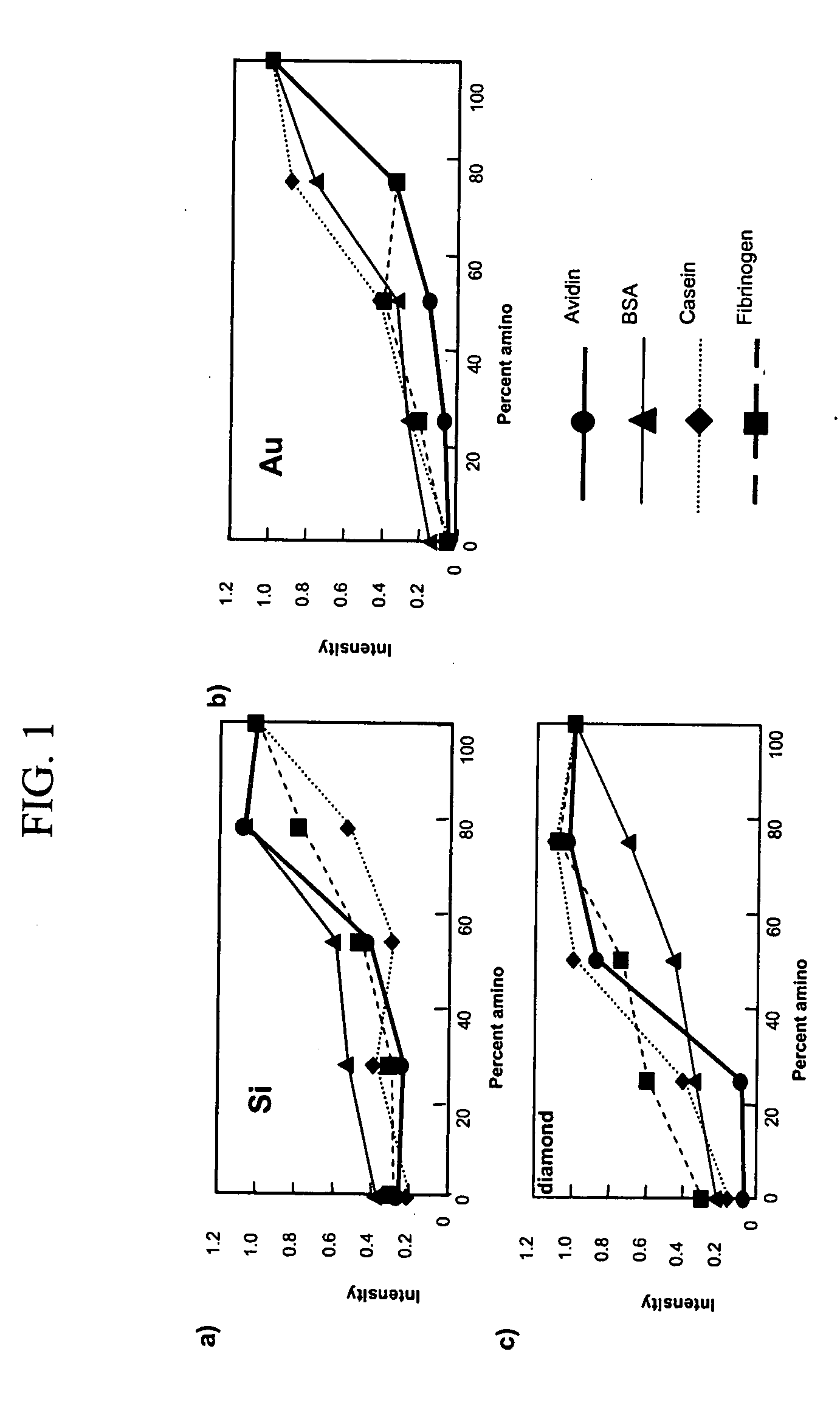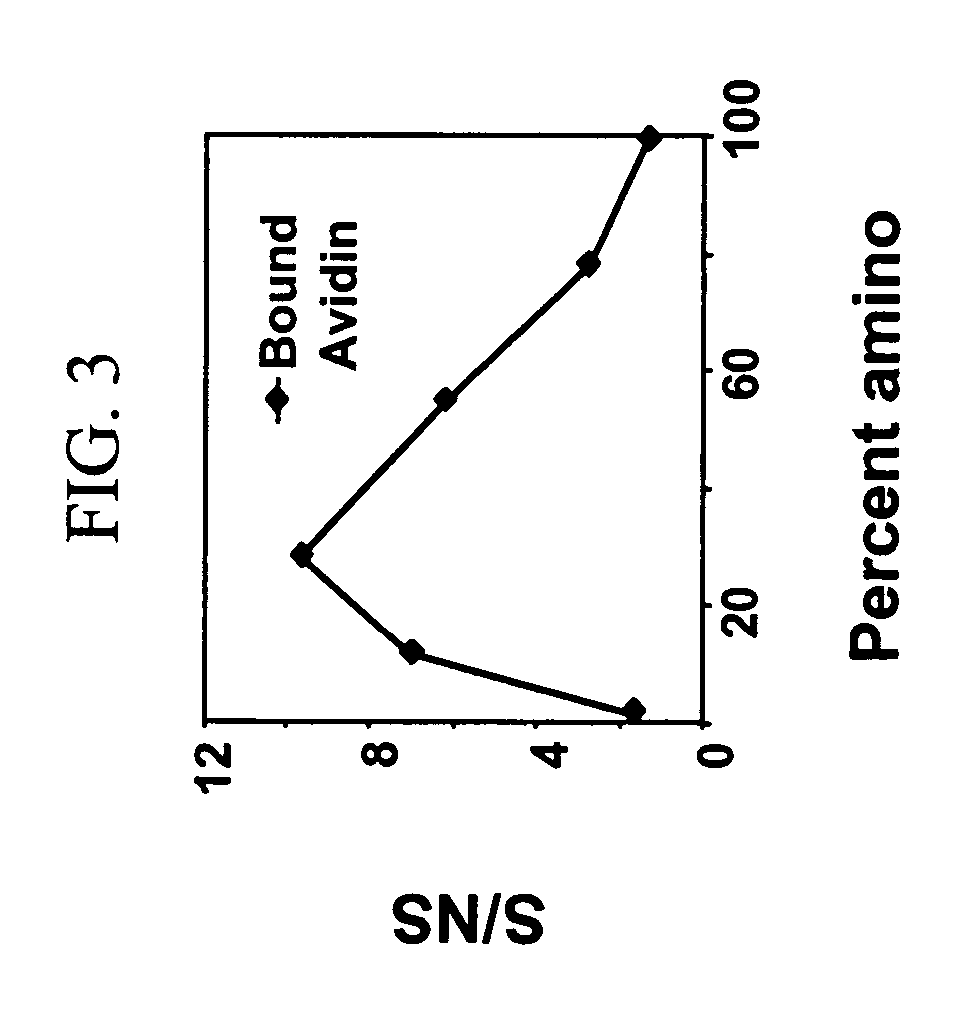Reduction of non-specific adsorption of biological agents on surfaces
a biological agent and surface technology, applied in the field of substrates, can solve the problems of insufficient poor fouling of biosensors, etc., and achieve the effect of reducing the non-specific binding of biological agents and reducing the non-specific adsorption of biological agents
- Summary
- Abstract
- Description
- Claims
- Application Information
AI Technical Summary
Benefits of technology
Problems solved by technology
Method used
Image
Examples
example 1
Mixed Monolayers of Triethylene Glycol Oligomers and Amine-Functional Molecules on Silicon and Diamond Surfaces
[0041] Mixed monolayers presenting both amine and triethylene glycol (EG3) functionalities were prepared on silicon and diamond substrates. The incorporation of amines into the monolayer allowed for subsequent chemical modification of these interfaces. The mixed monolayers were formed by applying solutions of various mole percentages of triethylene glycol undec-1-ene (EG3-ene) and t-Boc 10-aminodec-1-ene (BocN-ene) onto hydrogen-terminated silicon (111) surfaces or TFA protected 10-aminodec-1-ene (TFA-N-ene) onto hydrogen-terminated polycrystalline, p-type diamond thin films. Methods for covalently attaching Boc-N-ene to silicon surfaces is described in Strother T; Hamers R. J.; Smith L. M.; NUCLEIC ACIDS RESEARCH 28 (18): 3535-3541 Sep. 15 2000. Methods for covalently attaching TFA-N-ene to diamond surfaces is described in Yang, W. S.; Auciello, O.; Butler, J. E.; Cai, W....
example 2
Mixed Monolayers of Triethylene Glycol Oligomers and Amine-Functional Molecules on Silicon and Diamond Surfaces
[0047] Hydrogen-terminated Silicon (111) surfaces were prepared by cleaning in acidic and basic solutions, followed by etching in nitrogen-sparged 40% NH4F for 30 min. This process is described in greater detail in Strother, T.; Cai, W.; Zhao, X.; Hamers, R. J.; Smith, L. M., J. Am. Chem. Soc. 2000, 122, 1205-1209, the entire disclosure of which is incorporated herein by reference. Hydrogen-terminated diamond surfaces were prepared by acid cleaning followed by hydrogen plasma treatment, as reported in Strother, T.; Knickerbocker, T.; Russell, J. N. Jr.; Butler, J. E.; Smith, L. M.; Hamers, R. J., Langmuir 2002, 18, 968-971., the entire disclosure of which is incorporated herein by reference. Covalent monolayers were then formed on these surfaces by exposing the hydrogen-terminated surface to a parent liquid of the desired molecule under UV light for 3 h in the case of sili...
PUM
| Property | Measurement | Unit |
|---|---|---|
| Fraction | aaaaa | aaaaa |
| Fraction | aaaaa | aaaaa |
| Fraction | aaaaa | aaaaa |
Abstract
Description
Claims
Application Information
 Login to View More
Login to View More - R&D
- Intellectual Property
- Life Sciences
- Materials
- Tech Scout
- Unparalleled Data Quality
- Higher Quality Content
- 60% Fewer Hallucinations
Browse by: Latest US Patents, China's latest patents, Technical Efficacy Thesaurus, Application Domain, Technology Topic, Popular Technical Reports.
© 2025 PatSnap. All rights reserved.Legal|Privacy policy|Modern Slavery Act Transparency Statement|Sitemap|About US| Contact US: help@patsnap.com



